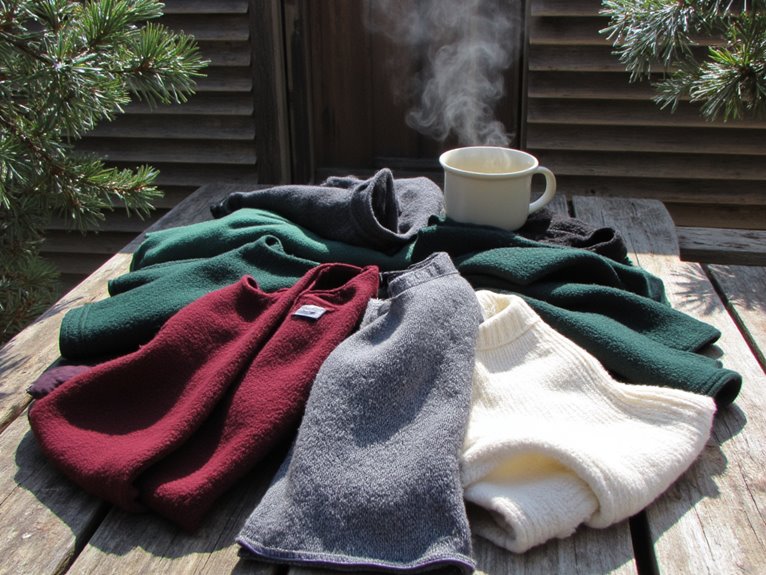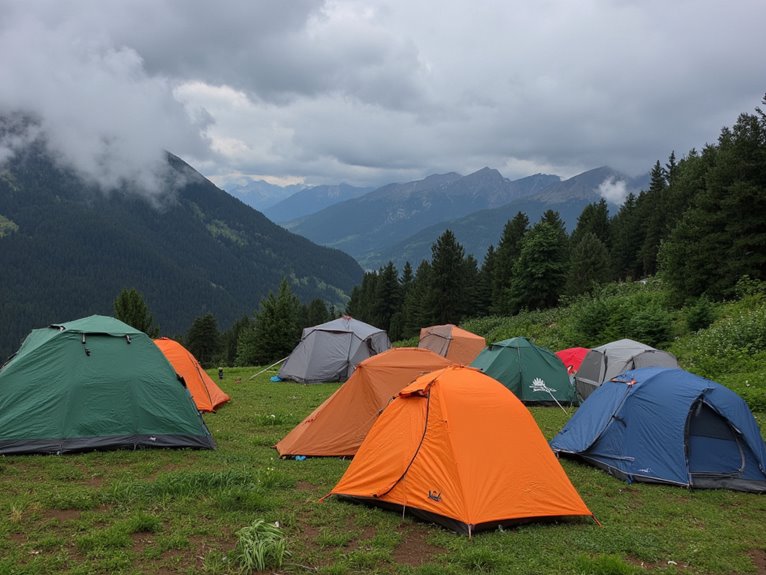Which Is Better B2 or B3 Mountaineering Boots?
When choosing between B2 and B3 mountaineering boots, consider your climbing style, terrain, and personal preferences. B2 boots excel in general mountaineering and glacier travel, offering a more relaxed fit and lower profile. B3 boots, engineered for technical climbing and ice climbing, provide a more substantial, robust build with added support and protection. Evaluate key features, such as ankle support, crampon compatibility, and insulation, to make an informed decision. As you venture into the world of mountaineering, the right boots can make all the difference – and understanding their unique strengths will set you up for success on your next adventure.
We are supported by our audience. When you purchase through links on our site, we may earn an affiliate commission, at no extra cost for you. Learn more. Last update on 6th January 2026 / Images from Amazon Product Advertising API.
Understanding B2 Boot Features
Characterized by their robust design and versatility, B2 mountaineering boots boast a range of features that make them an ideal choice for tackling challenging alpine terrain.
One of the key benefits of B2 boots is their exceptional ankle support, which provides stability and confidence on uneven and rocky surfaces.
Additionally, the boots' waterproof and breathable membranes guarantee that feet remain dry and comfortable in a variety of weather conditions.
The rugged outsole, designed for grip and traction, allows climbers to navigate icy and slippery surfaces with ease.
In addition, the boots' insulation and thermal lining provide warmth in cold conditions, making them suitable for winter mountaineering.
Examining B3 Boot Capabilities
In the realm of B3 mountaineering boots, their capabilities are truly put to the test on varied terrain, where superior traction is essential for safe and successful ascents.
Additionally, their performance on ice is a critical factor, as climbers rely on their boots to provide the necessary grip and stability to conquer frozen waterfalls and glaciers.
In this regard, B3 boots must also balance ankle mobility with support, allowing climbers to navigate challenging routes with confidence and agility.
Traction on Varied Terrain
B3 boots are engineered to provide unwavering grip on diverse terrain, from slick rock faces to snow-covered glaciers, allowing mountaineers to tackle complex routes with confidence.
The aggressive tread pattern and lug design of B3 boots provide stability and traction on uneven surfaces, while the rubber compound provides exceptional grip on wet and icy surfaces.
Whether tackling steep scree slopes or traversing rocky outcroppings, B3 boots deliver reliable performance.
The rugged outsole is designed to withstand the rigors of demanding terrain, giving mountaineers the confidence to push beyond their limits.
With B3 boots, climbers can focus on the ascent, knowing their footwear has got their back.
Ice Climbing Performance
Three essential features – crampon compatibility, ankle flexibility, and thermal insulation – make B3 boots an ideal choice for ice climbing enthusiasts.
These boots are specifically designed to accommodate crampons, providing a secure and stable platform for tackling vertical ice formations.
The ankle flexibility allows for a full range of motion, enabling climbers to maintain balance and precision on the ice wall.
Additionally, the thermal insulation guarantees that feet remain warm and dry, even in freezing temperatures.
This trifecta of features enables B3 boots to deliver exceptional performance on ice, giving climbers the confidence to push their limits and conquer the most challenging ice routes.
Ankle Mobility and Support
A well-designed B3 boot features an articulated ankle system, allowing for a remarkable 60-degree range of motion, thereby facilitating agile and precise movements on the ice.
This exceptional mobility enables climbers to navigate complex ice formations with confidence and precision.
The boot's sturdy upper material provides robust support, ensuring that the ankle remains stable and secure, even in the most demanding climbing conditions.
Additionally, the ankle system's flexibility allows for a more natural gait, reducing fatigue and enhancing overall climbing performance.
Key Differences in Design
Regarding design, a primary distinction between B2 and B3 mountaineering boots lies in their intended use and resulting build characteristics.
B2 boots are designed for general mountaineering and glacier travel, with a more relaxed fit and a lower profile. They are ideal for traversing varied terrain and provide a comfortable, flexible design.
In contrast, B3 boots are engineered for more extreme, technical climbing and ice climbing. They have a more substantial, robust build, with a higher ankle collar and a stiffer sole, providing added support and protection for challenging ascents.
These fundamental design differences substantially impact the performance and functionality of each boot type, making them suited to distinct climbing environments and objectives.
Ankle Support and Stiffness
When venturing into rugged terrain, ankle support and stiffness become crucial factors in mountaineering boots.
The right balance between mobility and stability is essential to tackle challenging landscapes.
In this context, we'll examine how B2 and B3 boots differ in terms of ankle mobility restrictions, stiffness in harsh terrain, and support for twists and rolls.
Ankle Mobility Restrictions
In B2 or B3 mountaineering boots, ankle mobility restrictions are a deliberate design feature, as they provide essential ankle support and stiffness to guarantee a secure footing on uneven terrain.
This restriction allows the boot to absorb shock and distribute pressure, reducing the risk of ankle rolls and sprains.
The stiffness also enables efficient energy transfer, allowing you to tackle challenging terrain with confidence.
While ankle mobility is limited, the benefits of added support and stability far outweigh the drawbacks.
Stiffness in Harsh Terrain
As you venture into harsh terrain, the stiffness of B2 and B3 mountaineering boots becomes a vital component in maintaining stability and support, allowing you to tackle rugged landscapes with confidence.
A stiffer boot provides better ankle support, reducing the risk of twists and sprains. This is particularly important when traversing treacherous terrain, such as:
Rocky mountain trails where every step counts
Glaciers where crevasses lurk beneath the surface
Steep scree slopes where one misstep can be disastrous
In these environments, the stiffness of your boots can be the difference between a successful ascent and a potentially disastrous fall.
Support for Twists and Rolls
The stiffness of B2 and B3 mountaineering boots provides critical ankle support, enabling climbers to tackle treacherous terrain with confidence, by reducing the risk of twists and rolls that can lead to debilitating injuries.
Both boot models feature a high-cut design that wraps snugly around the ankle, providing lateral support and stability. This design guarantees that the ankle remains secure, even on uneven or slippery surfaces, allowing climbers to navigate challenging routes with confidence.
Additionally, the stiffness of the boots helps to prevent excessive ankle rotation, reducing the risk of strains and sprains. By providing exceptional ankle support, B2 and B3 mountaineering boots empower climbers to push their limits and conquer the most demanding terrain.
Crampon Compatibility Matters
Every pair of B2 or B3 mountaineering boots is designed to accommodate a specific type of crampon, making it essential to guarantee compatibility between the two. This vital aspect cannot be overlooked, as it directly affects the performance and safety of your climb.
Three key points are vital when verifying crampon compatibility:
- Crampon style: Verify the crampon style matches the boot's binding system.
- Binding type: Check the binding type, such as step-in or strap-on, is compatible with the boot.
- Boot shape and size: Confirm the crampon fits snugly on the boot, without compromising its performance or safety features.
Insulation and Waterproofing
Proper insulation and waterproofing are essential components of a reliable B2 or B3 mountaineering boot, guaranteeing feet remain warm, dry, and comfortable throughout the climb.
Insulation materials like Thinsulate, PrimaLoft, or synthetic insulation provide adequate warmth in cold conditions.
A waterproof and breathable membrane, such as Gore-Tex or eVent, prevents water ingress while allowing moisture to escape. This maintains that feet remain dry and comfortable, even in wet or snowy conditions.
A well-insulated and waterproof boot also helps prevent cold-related injuries and frostbite.
Look for boots with a high level of waterproofing, such as a 10,000mm water column rating, to safeguard your feet stay dry in extreme conditions.
Weight and Flexibility Compared
Climbers seeking high-performance mountaineering boots must balance the trade-off between weight and flexibility, as a boot's ability to provide support and stability is often inversely proportional to its agility and responsiveness.
A lighter boot may sacrifice some support for increased mobility, while a more rigid boot may provide superior stability at the cost of reduced flexibility.
Three key differences exist:
B2 boots typically weigh around 1.5 kg (3.3 lbs) and offer a more flexible sole for improved agility on technical terrain.
B3 boots weigh around 1.8 kg (3.9 lbs) and provide increased support and stability for longer, more demanding climbs.
The weight difference can greatly impact your climbing experience, so it's essential to choose the right boot for your climbing style and objectives, keeping these factors in mind.
Choosing Boots for Climbing Style
When tackling glaciers, ice walls, or sheer rock faces, the type of mountaineering boot that best complements your climbing style can be the difference between success and setbacks.
For glacier travel or snow climbing, a boot with a more relaxed fit and a gaiter-compatible design is ideal.
For ice climbing, a stiffer boot with a more aggressive sole and crampon-compatible design is preferred.
For rock climbing, a more flexible boot with a snug fit and a sticky sole is best.
Consider your primary climbing discipline and choose a boot that aligns with your needs.
Making an Informed Decision
To guarantee you're equipped for success, it's essential to carefully evaluate the key features and specifications of B2 or B3 mountaineering boots, weighing the trade-offs between factors like ankle mobility, insulation, and crampon compatibility.
When making your decision, consider the following key factors:
- Terrain adaptability: Will you be tackling glaciers, ice walls, or rocky terrain?
- Weather resilience: Do you need boots that can withstand extreme cold, wet, or windy conditions?
- Personal comfort: How much ankle mobility and cushioning do you require for optimal performance?



